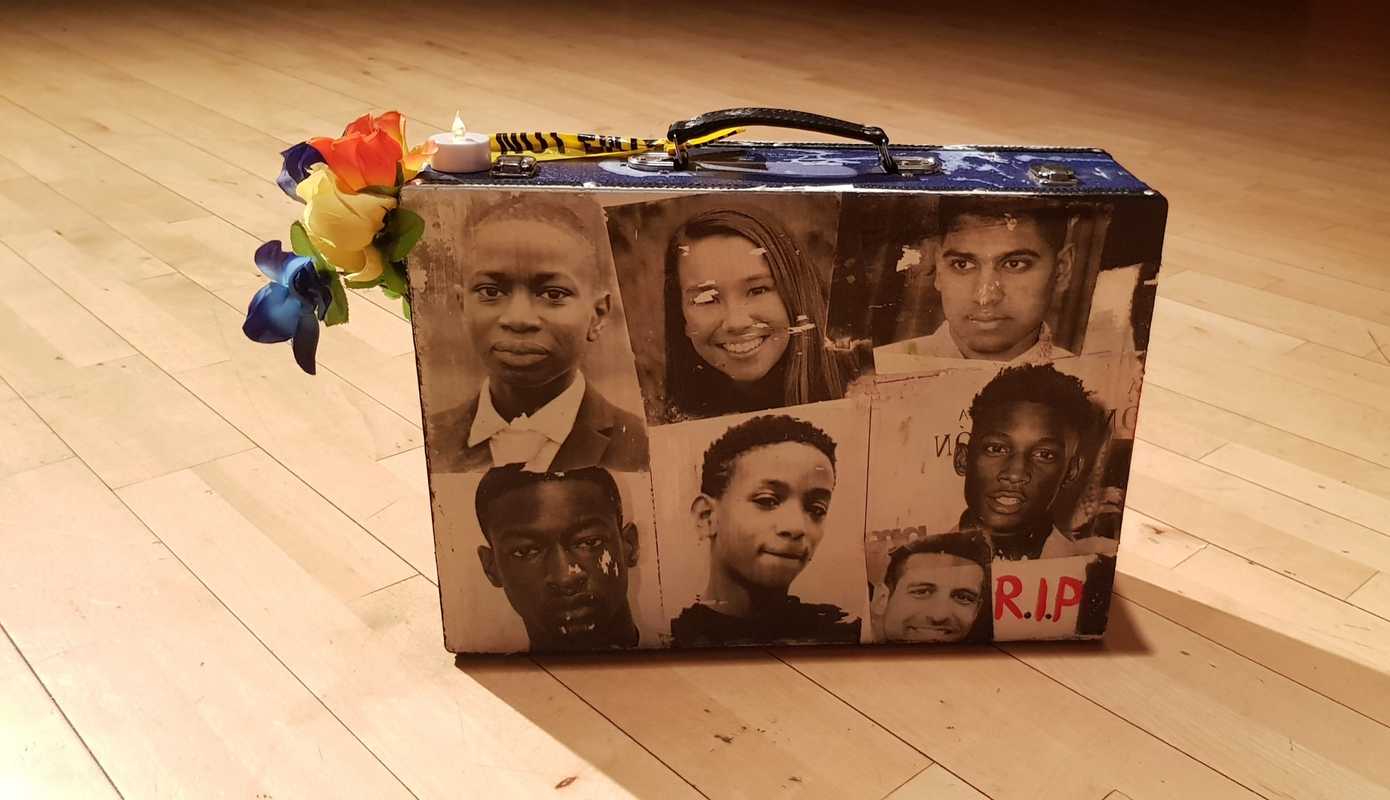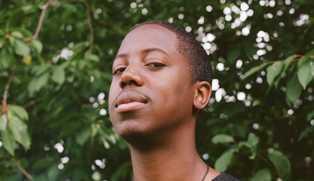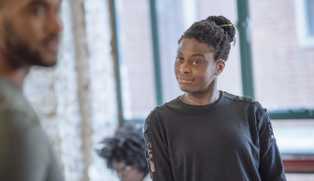We need to be honest about the ties between austerity and knife crime in the UK. It is devastating that we are losing lives over destructive tendencies that stem from racist power dynamics. Sadly, I lost a family friend, Koy Bentley, when he was stabbed at fifteen, on June 5th, two years ago. His killers have not been found guilty and it has been a constant struggle to get information from the police as to why they haven’t investigated his death thoroughly. It is a reminder that our safety and lives are not valued in the same way as our white counterparts.
Eugene Ankomah is a prolific Black British visual artist with Ghanaian heritage. His art practice has spanned over twenty-five years – he continually explores political issues and his approach is incredibly provocative and surreal. He asks his viewer to delve into their subconscious minds and search for an alternative to the reality that we have been presented with. Ankomah completed his third residency at The Salmon Youth Centre in 2009. Ten years later he has kept the flame going, working directly with the young community of South London on a collaborative art installation that focuses on the effects of knife crime on working class, under-resourced, marginalized communities in the UK
I was drawn to Eugene’s work ‘Re-Claim’ because it is frank, emotional and powerful. It allows the viewer to access emotions that are often experienced behind closed doors, and enables us to mourn collectively. Below is our lightly edited conversation.
*
Yasmine Akim: What do you feel is the importance of art and community work right now?
Eugene Ankomah: I think right now art is a catalyst for change. Its use as a tool to raise awareness, especially of social issues, has never been greater or more vital. For those reasons, the community aspect of art is very important, as the community is also part of the audience. In fact, in some situations they are the targeted audience, as art doesn’t feel as exclusive anymore. So directing the message or expressions of art to the community is a must.
YA: What was your intended message with the ‘Re-Claim’ art installation, and what was the process of putting it together like?
EA: There were several messages. I wanted to take a serious theme or social issue such as knife crime – which is affecting our society and our communities, especially our young people, and in way give it an artistic make-over, and re-present it back to the world. But in a way that was unique and powerful enough to remove the perception that certain people or communities had become immune to the issue of knife crime. I then wanted to get people to re-engage with the disastrous effects of knife crime all over again, in a fresh way in the hope that people would take it seriously. I wanted the audience – especially young people coming to see it – to experience it deeply enough to re-think their possible involvement in picking up knives.
I also wanted it to be interactive. To put the audience in a physical and psychological space where they became an integral part of the story. I wanted anyone entering the space to be included in the conversation. So everyone immediately, without choice, became part of the dialogue and therefore potentially part of the solution.
Another element that was important from the beginning was the process of working with a group of young people, between the ages of ten and 24. I wanted to capture their authentic expression, and for the audience to experience the raw expressive language honestly and boldly. Therefore, it had to be a collaboration between myself and them.
Lastly, it had to be clear to all involved that the piece was ultimately an expression and celebration of the preciousness and sacredness of life, and not about death.

YA: How was your work received at The Salmon Youth Centre?
EA: It was simply overwhelming. I don’t think the Salmon Centre expected the feedback and emotional responses that they received, both from its young people or the community at large. To witness people tearing up and others unapologetically crying whilst exploring the work was a truly unbelievable experience for the staff and myself. Many others were also keen to give their perspective on camera. We are still buzzing from the energy received weeks after the show ended. I am still receiving emails from various organisations who are wanting to either show the installation, or have me recreate a version of it at their premises. Let’s just say the potential with this project is very interesting.
YA: Can you see a relation between a lack of opportunity available to young black people in the UK and knife crime?
EA: I have absolutely no doubt that the lack of opportunity has led to a major increase in knife crime in the UK. There are documentaries, reports and what you hear from reformed gang members or convicted criminals that makes it pretty clear that a lot of young people feel let down by a system which seems to be ignoring their needs.
Other research I did through talking to young people at the Salmon Centre proved to me that boredom within young people is far more dangerous than we might like to admit. I produced an experimental soundtrack as part of the ‘Re-claim’ installation and in that I use audio taken straight from an interview with a kid who says “…but they have nothing for us to do”. That sums it all up. He blames the lack of activities and the community centers being shut down for the anger.
YA: Do you feel like art can be inaccessible to marginalized youth because of where it is often situated?
EA: I feel that locations are definitely part of the reason [marginalized] youth often find art inaccessible. In my experience mentoring and working with young people, not only do you suspect [that is the case], you actually hear them say it. Often [galleries] are perceived as being ‘too posh,’ or seen as ‘not for them.’ Galleries are places that house art they feel they do not understand. They also seem to feel they may not connect with ‘the gallery crowd.’ The psychological barrier deters a lot of young people from really exploring the rich visual, intellectual and cultural benefits of art.
YA: What mediums do you work with and why?
EA: I work with the medium of psychology. It’s like an invisible material to me that reminds me I am creating and dealing with people. So choosing physical materials to communicate the idea or concept is not difficult. Whether I choose to work through painting, performance, installation, sound or even a combination of all those things is just a matter of creatively deciding what would be most powerful in the mind and heart.
YA: How can more creatives get involved with community work with young people?
EA: By first developing an understanding that some of us creatives possess abilities which are needed out there in the world, especially by young people who are often still searching for themselves and are in need of encouragement and mentorship. By engaging with them through the arts, it’s like giving them a gift. One that will probably help them gain confidence, and help them to understand themselves better. I think the next step of actually finding a location, company and organisation is just a matter of asking the places you see or know about.
YA: What are your plans for the future?
EA: My immediate plan for 2019 is to push ‘Re-Claim’ forward by having the work shown in other galleries and venues that allow young people to make the best of it. The project will be touring around the country, but this also depends on available funding, so all fingers crossed on that. I also have had some powerful ideas that have sprung up out of ‘Re-Claim’ that I would like to be making, so I’m excited about that.





